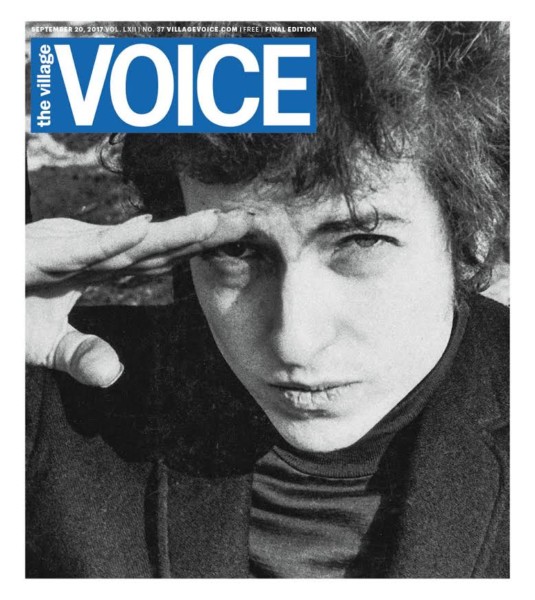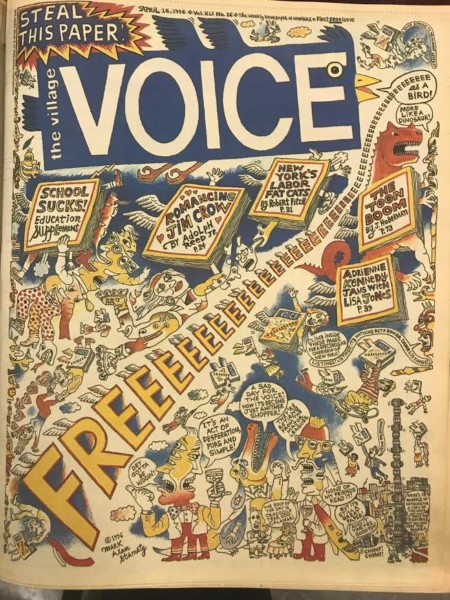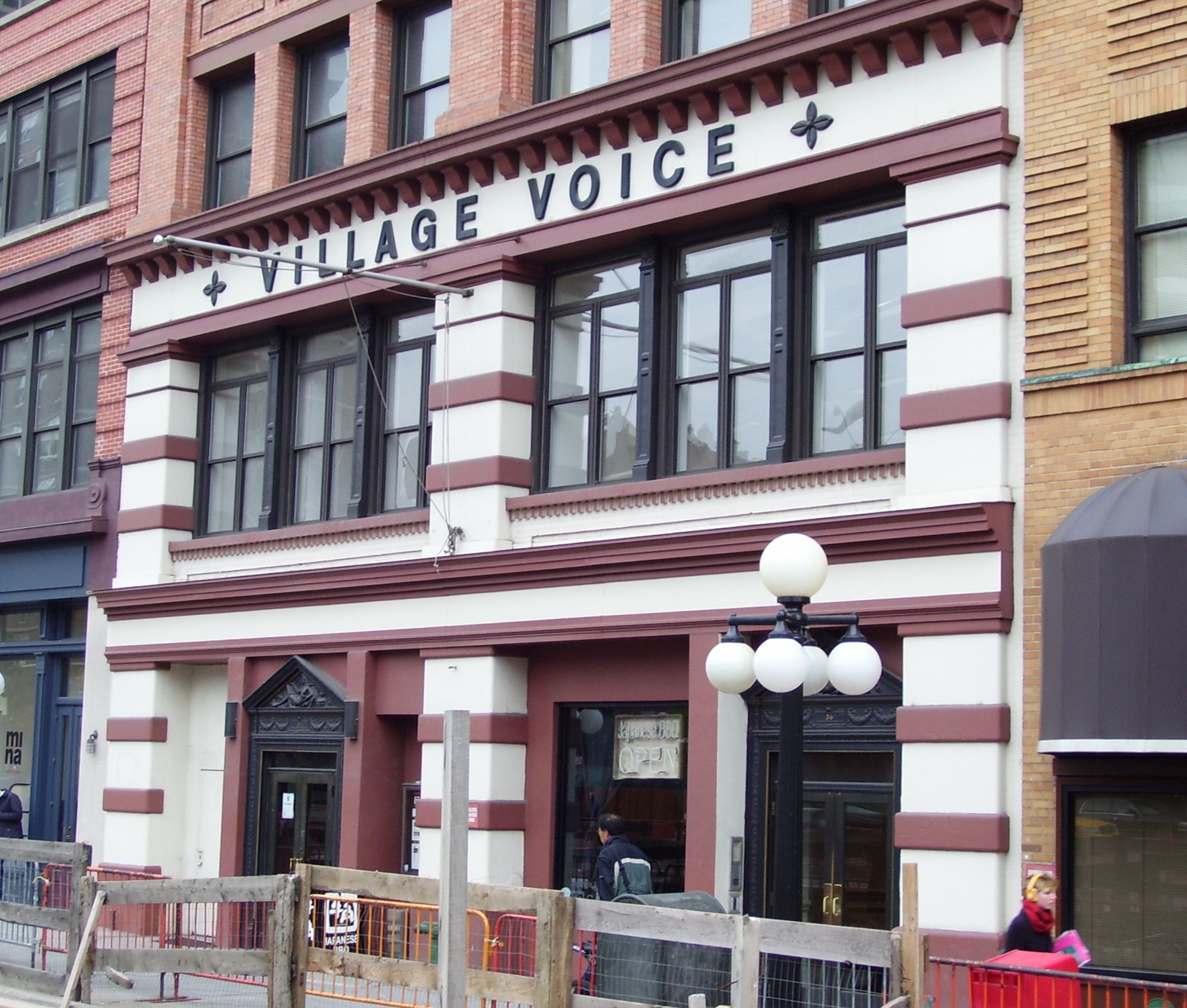Sign up for The Media Today, CJR’s daily newsletter.
Today’s the day: The last print edition of The Village Voice hit newsstands this morning—or it was supposed to, anyways. At 7:20am, I walked two blocks from my Washington Heights apartment looking for a copy. The box was empty. Three boxes near Columbia University’s Morningside Heights campus held the penultimate issue. A woman working at a nearby newsstand shrugged her shoulders when I asked if she’d seen any new copies yet. But by 8am, a copy of the last issue had surfaced on Ebay, on sale for $15.
The announcement of the end of the print edition of the 62-year-old giant was met with a wave of nostalgia from former writers, editors, and readers last month, when Pennsylvania-based owner Peter Barbey announced a late-in-the-game shift to a digital-only operation, with a focus on “new events, products, and initiatives.” (The Voice is nothing if not regular stream of drama: Soon after, the company announced that 13 of its remaining 17 union members would be laid off. I worked as a staff writer there from June 2016 through last month.)
The bold image chosen to grace the last cover to populate those familiar, grimey red boxes scattered across New York City? Bob Dylan.
Bob Dylan?
Pleasing fans of The Village Voice has never been easy—and for much of the alt-weekly’s history, according to a Village Voice employee who spoke to me on condition of anonymity, the newspaper “could say fuck you to anyone,” including the readers it served. But in arguably the most important year in generations for the type of scrappy, nobody-is-safe news reporting the Voice defined, featuring a long irrelevant (albeit a Greenwich Village icon) music star on the cover seems at best a missed opportunity. At worst, safe.
ICYMI: America’s growing news deserts
As the president, a New Yorker long interrogated by the Voice’s most esteemed reporters, is investigated for inappropriate dealings with the Russian government, as Congress stumbles its way through healthcare reform that could result in the deaths of vulnerable Americans, as the institution of the press itself faces unprecedented berating from the highest rungs of government and increased scrutiny and resentment from the public, this was the most relevant image for the final, 176-page commemorative issue of an openly progressive newspaper long credited for its ability to capture the zeitgeist?
I wasn’t the only one underwhelmed.
“It’s really embarrassing,” a Voice employee said, bluntly. “It just doesn’t feel relevant or specific to the Voice. We ran Bob Dylan on the cover … a month ago. I was hoping for something a little more original that felt specific to the paper.”

The cover of the final issue of The Village Voice.
The decision seems in line with a trend toward prioritizing arts and culture reporting over traditional news reporting, as evidenced by a quick scan of the covers so far this year. In the nine months since Donald Trump was sworn in as president, the Voice has released just four hard-news cover stories—a misstep during a never-ending news cycle focused primarily on a story (Trump) the Voice had been hip to for, quite literally, decades. (It’s five hard-news covers if you count a photo essay of protests in front of Trump Tower on the president’s first post-inauguration visit to New York City.)
This is not to say Voice writers and freelancers have not worked hard to pursue such stories. Impressive reporting on the continued disarray of the city’s public transportation system, on the local consequences of Trump’s repeat attempts at a Muslim travel ban and dedication to the deportation of undocumented immigrants, and regular accountability reporting from City Hall and the New York Police Department, among others, has filled the interior pages of the alt-weekly.
In the nine months since Donald Trump was sworn in as president, the Voice has released just four hard-news cover stories.
But the cover of any newspaper communicates to readers the most important story of the week. And if we are to learn anything from recent cover choices at the Voice, stories that have populated covers and homepages of peer publications—the ones with outsized impact on marginalized communities—have taken a noticeable backseat. And while poignant coverage of the art world has been and will continue to be a strength and crucial part of the legacy of the Voice, such an imbalance stands out given the political firestorm that has dominated the last two years of American life.
ICYMI: If there’s a future for The Village Voice, it’s digital
One Voice employee spoke of concern amongst current and former staff members that a “desire for softer, feel-good stories” could dominate the company’s transition to a singularly digital outlet. “I think there’s a fear of hard news stories coming from the top,” the employee said.
I’m told top editors drew up several options for the last cover, including an old, quirky black-and-white image of beloved columnist Michael Musto (a special edition of his famous column, La Dolce Musto, appears in the issue) hitchhiking while wearing nothing but a trench coat and tighty whities. A proposed cover line was, “One For The Road.” The mock-up was a popular pick amongst staff—an ode to the weird and wonderful—but ultimately the Dylan cover was shipped off to the Staten Island presses, one last time.
“It’s a tough cover to choose because it has to be backward-looking in a way, which is a tough thing when you’re a news [weekly]. I can sympathize with how tough it is to pick that, but I saw other candidates that I thought were better,” says Mike Laws, former copy chief at the Voice who oversaw the mammoth effort to copyedit the 176-page commemorative issue before joining the copy desk at The Nation.
Another Voice employee echoed the disappointment. “I think [the Dylan cover] is nostalgic. Is it representative of the Voice? Is that the photo? No,” he says. “It’s a safe choice, and the Voice was never criticized for being safe. Some people are going to like it. [Other] people are going to pick it up and go, why this photo?”
The current of change is a familiar one at the Voice. In 1996, the paper transitioned from a paid weekly to a free one. On April 16 of that year, the first free issue hit newsstands. The cover, an illustration by Mark Alan Stamaty, was a frenetic collection of freaks: four-eyed men with elephant trunks for noses, a woman whose neck was shared with a rhinoceros and, in the upper left hand corner, instructions to “steal this paper.” Thought bubbles full of criticisms of the paper’s decision litter the page:
“A sad day for the Voice! Now it’s become just another shopper!”
“An act of desperation, pure and simple!”
“None of my friends read it!”

The first free issue of The Village Voice.
It was an example of masterful self-deprecation in the spirit of Voice newsrooms past and present, one that hits exactly the right tone during a time of begrudging transition—and features hard news reports and the arts, including writing by Adolph Reed Jr. on the romanticization of Jim Crow, on New York labor unions by Robert Fitch and an arts dispatch on Adrienne Kennedy. A cover emulating this spirit of diversity could have been a more fitting farewell to a beloved institution about to shed its skin.
Despite its lackluster cover, the last issue comes packed with both nostalgia and important reporting on climate change, including hurricane preparation and relief efforts in New York, the Bahamas, Barbuda, and the US Virgin Islands, as well as in Puerto Rico and Cuba. Steven Wishnia investigates how New York City landlords undermine affordable housing protections through the use of “preferential rent.” A 50-page yearbook-like portfolio features images of Voice co-founder Ed Fancher and prominent alumni such as Amy Taubin, Michael Feingold, Jerry Saltz, Roberta Smith, and others, as well as classic New York City street photography from old Voice photographers. Long-time Voice staffer R.C. Baker says goodbye to the printing press in an essay, and Voice illustrators tackle the political war gripping the country in a series of cartoons. (Not everything is online yet, as the Voice staggers its digital release of stories.)
Luckily, there are still traces of that old, sardonic Voice humor spread throughout its pages, if you look closely.
On the table of contents, look for two corrections, one from a 1955 issue and the other from 1969. In the legalese at the bottom, a sneaky editor changed the verb tense from present to past throughout. And on the masthead, a couple of quirky nicknames have been written into the names of the copy editing team.
But the most masterful trick of all can be found in the last paragraph of the newspaper. One “Vivian Darkbloom” (a character from Vladimir Nabokov’s Lolita, and an anagram of his name) snuck an acrostic poem into the Voice Choices section: “Pinch every penny, Pete.”
ICYMI: CNN anchor gives startling hurricane report. The only problem? What’s in the background.
Has America ever needed a media defender more than now? Help us by joining CJR today.



